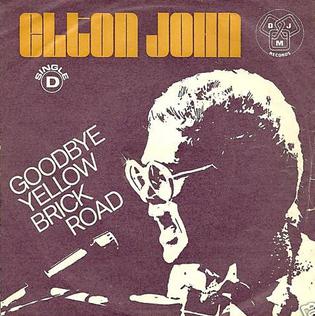 | Goodbye Yellow Brick RoadElton John |
Writer(s): Elton John (music), Bernie Taupin (lyrics) (see lyrics here) Released: September 7, 1973 First Charted: September 29, 1973 Peak: 2 BB, 11 CB, 11 GR, 11 HR, 13 RR, 7 AC, 1 CL, 6 UK, 11 CN, 4 AU, 6 DF (Click for codes to charts.) Sales (in millions): 2.0 US, 0.2 UK, 2.2 world (includes US + UK) Airplay/Streaming (in millions): 4.0 radio, 50.73 video, 324.4 streaming |
Awards:Click on award for more details. |
About the Song:The title cut for Elton John’s seventh album, Goodbye Yellow Brick Road, was released as the second single after “Saturday Night’s Alright for Fighting.” While “Saturday” peaked at #12, “Road” went to #2 on the Billboard Hot 100 and topped the charts on three of the other major pop charts in America at the time. The song was a top singles pick in the October 20, 1973 issue of Billboard which said, “Elton returns to a medium tempo for his large, round sounding production of a man returning to a simple life. At times it’s hard to understand Elton, but the sonic impression is still strong and haunting. The blending of voices with strings on the bridges is beautiful.” BB Circus magazine’s Janis Schach called the song “delicate and beautiful.” WK All Music Guide’s Stewart Mason has called it “a strong contender for the coveted title of John’s finest song ever.” AMG “Extravagant, but not pretentious,” AMG the “arrangement builds slowly…to a full orchestral climax at the end of each chorus.” AMG “The wordless melisma that decorates the bridge between the verse and chorus melodies is straight out of the Beach Boys playbook.” AMG “It’s very likely his single finest vocal moment.” AMG The title is a reference to The Wizard of Oz and the yellow brick road. Bernie Taupin, who wrote the lyrics, often wrote about Elton, but this song “about giving up a life of opulence for one of simplicity in a rural setting” SF appears to be more about Taupin as John “has enjoyed a very extravagant lifestyle.” SF Taupin said, “I was going through that whole ‘got to get back to my roots’ thing…I don’t believe I was ever turning my back on success…I think I was just hoping that maybe there was a happy medum way to exist successfully in a more tranquil setting.” SF It is also “evocative of faded Hollywood glamour;” AMG “a clear-eyed, somewhat bitter, but not vindictive kiss-off to a wealthy former paramour.” AMG Resources:
Related Links:First posted 4/12/2021; last updated 9/15/2023. |










